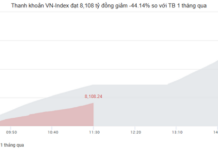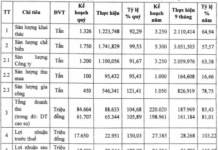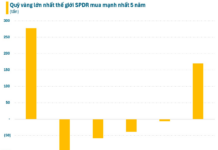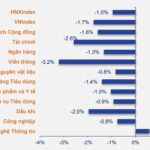Vietnam’s stock market experienced a volatile trading week from September 9-13, retreating to just above the 1,250-point support level. Overall, the VN-Index closed the week at 1,251.71 points, a decrease of 22.25 points (-1.75%) from the previous week. Notably, cautious market sentiment led to low trading liquidity, with the average matched order trading volume on the HOSE reaching only VND 10,200 billion.
Looking ahead to the new trading week, experts provided a positive outlook for the VN-Index trend during the week when the Fed cuts interest rates. They suggested that the VN-Index is currently in an accumulation phase for the year-end rally and investors should take advantage of this period to increase their stock holdings around the 1,250-point support level of the VN-Index.

The market will not see unexpected fluctuations when the Fed cuts interest rates
Mr. Tran Truong Manh Hieu – Head of KIS Securities Analysis
The current downward trend is showing signs of slowing down as the VN-Index retests the 1,250-point threshold. This is a crucial support level for the market, and many investors are waiting to see if the index can hold above this level to determine the next trend. Additionally, the decreasing trading volume in recent sessions confirms this outlook.
If the index manages to stay above this level, an upward trend will resume, and the index will swiftly surpass the 1,300-point mark. However, for this rally to be sustainable, trading volume needs to increase simultaneously.
On the other hand, if the index falls below 1,250 points, the market may witness a sharp decline to retest the August 2024 lows, around the 1,180-1,200 range. Depending on subsequent developments, the market could then experience a significant rise or fall in the coming period.
Commenting on the consistently low liquidity, Mr. Hieu attributed it to investor caution during a downward trend, which is a typical market behavior. He assured that as the upward trend resumes, trading volume will also pick up. Therefore, investors need not worry about liquidity at this point.
Moreover, compared to other investment channels, the stock market remains attractive. Returns from the stock market outperform savings deposits, and the required capital is significantly lower than that of real estate investments. Hence, the majority of the population can afford to invest in stocks. Additionally, as the State Bank of Vietnam tightens control over the gold bar market, this investment avenue has become less appealing than before. These factors suggest that funds will continue flowing into the stock market despite the ongoing correction.
In its meeting next week, the Fed will initiate the process of reversing its monetary policy from tightening to easing. Specifically, the Fed will begin reducing interest rates, starting with a 0.25% cut, as signaled by Fed officials over the past few months.
Since this move has been widely anticipated by investors and experts, the market is not expected to witness significant volatility due to any “surprise” factor. The Vietnamese market may react positively at the beginning of the session but is likely to return to its current trend as there are no further surprises beyond market expectations.
Conversely, KIS analysts cautioned about the risk of strong selling pressure from foreign investors. Foreign investors have been net selling at record levels this year, exceeding VND 60 trillion on the HOSE, and this trend continues. Therefore, if this situation persists, the market will face short-term risks with a downward trend forming. Additionally, the lack of positive news contributes to investor caution. Some encouraging news is necessary to shift the market sentiment back to bullish.
Regarding investment strategies, investors can consider several stock groups with unique stories in the coming time.
Firstly, real estate: This sector has witnessed a significant decline recently and is now at attractive price levels. With the new Land Law, legal issues will be addressed, allowing many businesses to restart their stalled projects.
Secondly, the construction materials – steel industry: This sector is expected to benefit from the recovery of the real estate market and the increasing demand for construction materials. Additionally, the rise in government spending on infrastructure projects can be a crucial catalyst for this industry.
Increase holdings around the 1,250-point level
Mr. Dinh Quang Hinh – Head of Macroeconomics and Market Strategy, VNDIRECT Analysis Department
Investors should maintain a long-term perspective, as market corrections present opportunities to accumulate stocks. The market remained subdued last week due to caution ahead of crucial macroeconomic events: (1) the Fed’s upcoming meeting, where they are expected to cut interest rates for the first time this year, (2) market anticipation of SBV’s response to the Fed’s rate cut, and (3) the impact of Typhoon Yagi, the strongest in decades, on northern Vietnam, disrupting the operations of many businesses.
The expert remains optimistic about the prospects of Vietnam’s stock market in the latter part of the year. He believes that the VN-Index surpassing the 1,300-point threshold this year is achievable, supported by the following factors: (1) the Fed is expected to lower its policy rate by approximately 0.75% in the final months of the year, (2) easing pressure on exchange rates and inflation will enable the SBV to shift its focus to economic growth, increasing money supply and maintaining low-interest rates, (3) listed companies’ business results continue to improve, and (4) progress in the market upgrade story.
Historical data also suggests that “market peaks occur during periods of high trading activity, while market bottoms form during periods of low liquidity.” Therefore, Mr. Hinh advised that the VN-Index is currently in an accumulation phase for the year-end rally. He recommended that investors increase their stock holdings around the 1,250-point support level of the VN-Index, prioritizing sectors with positive growth stories in the last months of the year, such as
banking, securities, import-export (textiles, seafood, wood products), and industrial real estate.
The Stock Market ‘Anticipates’ Next Week’s Key Event
The market experienced a rather dull trading week, with the last two sessions seeing the lowest liquidity since April 2023. Investor sentiment seems to be heavily impacted by the aftermath of the third storm, which disrupted the business operations of a significant number of enterprises. The market is also awaiting the response of the State Bank of Vietnam following the interest rate cut by the Federal Reserve.





































